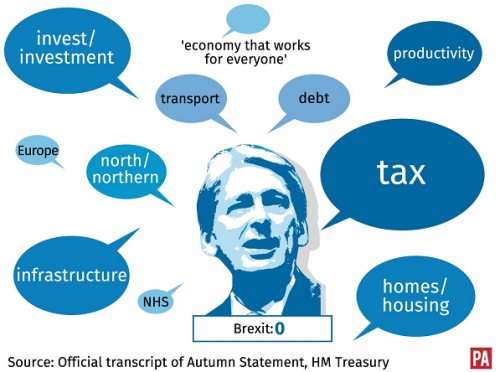Changes to Universal Credit being announced in Philip Hammond’s Autumn Statement will still leave many low-income families worse off next year, Labour has warned.
A 2p cut in the benefit’s “taper rate” is one of the key measures the Chancellor will announce as part of a package to help the “just about managing” people – known in Whitehall as the “Jams” – who Theresa May has identified as a priority for support.
His first economic statement as Chancellor will also include moves to help 4.3 million families in private rented accommodation by banning upfront letting agency fees, and a 4% hike in the minimum wage for over-25s – referred to as the National Living Wage by ministers – to £7.50 an hour next April.
The announcements form part of a statement expected to be dominated by the costs of Brexit, with reports suggesting the hit to public finances from withdrawal from the EU could reach £100 billion over five years.
Shadow chancellor John McDonnell said the Universal Credit initiative would only go a fraction of the way to redressing cuts in the benefit previously announced by Mr Hammond’s predecessor George Osborne and due to come into effect next year.

The IPPR think-tank calculated that Mr Hammond’s decision to cut the taper rate from 65% to 63% – so welfare is withdrawn at a rate of 63p in every extra pound earned by a low-paid worker, rather than 65p – would cost the Treasury £700 million a year by 2020/21, compared with the £3 billion saved by Mr Osborne reducing the “work allowance” threshold at which the withdrawals kick in.
Mr McDonnell cited analysis from the House of Commons Library which showed that:
:: A lone parent with two children on an income of £25,000 a year might be £2,300 worse off overall in 2017/18 after Mr Hammond’s changes, compared with £2,500 as a result of Mr Osborne’s cuts alone
:: A working couple, both on the minimum wage, with two children would be around £800 rather than £1,100 worse off

“If this Autumn Statement is supposed to relaunch the Conservative Party on the side of workers, then it has already failed,” said Mr McDonnell.
“Some working families, who will have lost as much as £2,500 a year, might only be getting back as little as £150 in this statement. It appears that Philip Hammond not only takes with one hand, he now pretends to give back with the other.”
Campaigners welcomed the ban on letting agency fees – which cost renters an average £337 when they move home – but noted that Conservatives opposed it when Ed Miliband included it in the Labour manifesto.

As recently as last month, housing minister Gavin Barwell dismissed a ban as a “bad idea”, warning that “landlords would pass cost to tenants via rent”.
After it emerged it will feature in Mr Hammond’s plans, Mr Barwell said: “It is the nature of the job that you have to defend current policy even when you’re working to change it.”
The increase in the National Living Wage, currently £7.20 an hour for workers aged 25 and over, brings it closer to the Government’s 2020 target of more than £9 an hour, but leaves it well below the independently calculated Living Wage of £8.45 across the UK and £9.75 in London.
Labour pointed out that the new £7.50 level is lower than the £7.60 rate projected for 2017 by the Office for Budget Responsibility in March.
 An additional £4.3 million a year will be committed to enforcing the payment of statutory minimum wage levels.
An additional £4.3 million a year will be committed to enforcing the payment of statutory minimum wage levels.
Mr Hammond is also expected to announce a £1.4 billion injection into affordable housing to help build 40,000 new homes.
The Treasury said Mr Hammond’s package was designed to “improve the living standards of ordinary working class people and their families”, in line with the ambitions set out by Mrs May in her keynote speech to the Conservative conference last month.
The Chancellor is expected to say that providing economic stability, restoring the public finances and boosting productivity are the best methods to improve living standards, which last year grew at their fastest rate in 14 years.

But he will also offer a range of measures to help family finances go further, including:
:: A crackdown on whiplash claims, designed to allow insurers to reduce premiums by £40 a year
:: Relaxation of restrictions on schemes like affordable rent, shared ownership and rent-to-buy, to help people in different housing circumstances, including renters struggling to save for a deposit
Former work and pensions secretary Iain Duncan Smith gave a cautious welcome to the Universal Credit changes.
He told the BBC Radio 4 Today programme: “I consider this really a down-payment – this is not game over.
“This is really about the fact the Chancellor has said, given the circumstances and given that we don’t know where we are going to be, necessarily, as we get into Brexit stuff over the next two years, he wants to give a strong indication that they want to help those who are struggling. Here’s a starter for this, let’s see where we go over the next two to three years.”
